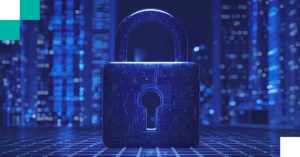We live in an age of digital transformation and businesses are now facing increasingly complex and sophisticated cyber security threats.Today’s businesses operate in complex digital environments which include cloud-first architectures, hybrid workforces, third-party integrations and legacy infrastructure, which all intersect to create sprawling attack surfaces.
In this context, simply hardening systems is no longer enough. Vulnerabilities are inevitable and not because of negligence, but because no environment can be perfectly sealed. Given enough time and resources, attackers will find a way in. The question is no longer if they will succeed, but how quickly you can detect and respond when they do.
This is where managed SOC monitoring becomes essential. Rather than depending solely on perimeter defences, managed SOC monitoring provides a strategic advantage by delivering continuous oversight of your environment, allowing threats to be detected and contained early.
Skilled SOC analysts offer real-time investigation and incident response, helping organisations take back control during an attack. And with forensic-quality log data, security teams can assess the full scope of an incident, offering assurance that sensitive data has not been compromised.
What Is Managed SOC Monitoring and How Does It Work?
Managed SOC monitoring refers to the outsourcing of Security Operations Center (SOC) functions to a specialised third-party provider. Rather than maintaining an in-house SOC team, businesses are able to partner with professionals who deliver continuous security monitoring, threat detection, incident response, as well as forensic investigation.
Key Functions of SOC Monitoring Include:
- Continuous Security Monitoring and Threat Detection: This involves 24/7 surveillance of networks, endpoints, cloud environments, and applications in order to detect signs of suspicious activity or policy violations.
- Incident Response and Forensic Investigation: As soon as a threat is detected, the SOC team will immediately investigate, contain, and mitigate the incident, while conducting forensic analysis to fully understand its origin and impact.
- Integration with Existing Security Infrastructure: Managed SOC services should integrate with a business’s existing security tools, including firewalls, intrusion detection systems and Identity Provider (IdP) platforms.
At Foxtech, our managed SOC monitoring services function as an extension of your internal security team and provide expert-level protection without the costs and complexities of building an in-house SOC.
The Growing Cyber Threats That Demand 24/7 Monitoring
Today, attackers are using more sophisticated tactics to bypass traditional defences and target businesses through a variety of tactics, including:
- Ransomware: Cybercriminals can encrypt business data and demand a ransom for its release which inevitably causes costly operational disruptions.
- Phishing: Smart and deceptive emails can be used to trick employees into giving out sensitive information or installing malware.
- Insider Threats: Employees or contractors can deliberately or unintentionally compromise data security.
- Supply Chain Compromises: Attackers exploit vulnerabilities in third-party software, services, or vendors to gain access to a business’s network and this often bypasses direct defences entirely.
Managed SOC monitoring services ensure that businesses detect and respond to these kinds of threats in real time, before they escalate into serious and costly breaches.
Key Benefits of Managed SOC Monitoring
Partnering with a managed SOC provider offers several advantages for businesses interested in enhancing their cybersecurity posture.
These benefits include:
- Real-Time Threat Detection: With constant monitoring, potential threats are identified and neutralised quickly which reduces the window of opportunity for attackers.
- Reduced Response Time: Faster incident response minimises business disruption, financial loss, and reputational damage.
- Cost-Effective Security Management: Building an internal SOC requires substantial investment in technology, skilled staff and infrastructure while managed SOC monitoring provides access to enterprise-level security at a fraction of the cost.
- Regulatory Compliance Support: A managed SOC helps businesses maintain compliance with frameworks such as GDPR, ISO 27001, and PCI DSS by providing audit-ready reports, continuous monitoring, and documentation of security controls.
How Managed SOC Monitoring Enhances Threat Detection and Response
Managed SOC monitoring strengthens a business’s ability to detect, analyse, and respond to threats promptly and effectively by leveraging advanced technologies, strategies and methodologies:
- Security Information and Event Management (SIEM): SIEM platforms collect and analyse logs from across the IT environment to identify threats.
- Threat Intelligence Feeds: Continuous updates from global threat intelligence sources help identify possible attack patterns and indicators of compromise (IoCs).
- AI and Machine Learning: Predictive analytics and automated behavioural analysis can detect once unknown threats and reduce false positives which allows for quicker decision-making.
By using these technologies and strategies, managed SOC monitoring identifies and addresses threats before they can cause damage.
Ensuring Compliance and Risk Management with Managed SOC
Compliance with data protection laws and industry regulations is a vital for businesses and managed SOC monitoring can play a critical role in achieving and maintaining compliance by:
- Conducting Continuous Security Audits: Regular assessments help businesses identify gaps and document security improvements.
- Providing Detailed Compliance Reporting: Managed SOC providers deliver clear, audit-ready reports that demonstrate adherence to GDPR, ISO 27001, PCI DSS, and other standards.
- Protecting Sensitive Data: Proactive threat detection and data loss prevention measures ensure that personal and confidential information remains secure.
Failure to comply with regulations can result in large fines as well as severe reputational damage all of which are consequences that can be mitigated with managed SOC services.
Choosing the Right Managed SOC Monitoring Provider
Selecting a professional and reliable managed SOC provider is crucial and here are key factors to consider when selecting your managed SOC provider:
- Experience in Cybersecurity Monitoring: Look for providers with a strong track record and experience across different industries.
- Threat Detection and Response Experience: Ensure the provider offers advanced detection technologies and rapid incident response capabilities.
- Availability of Continuous Monitoring and Real-Time Alerts: Continuous monitoring and real-time notification of incidents are vital to reducing risks.
- Scalability: Your provider should be able to scale services in line with your growth.
- Choose People with Context: Opt for UK-based consultants who bring real-world awareness to your business rather than offshore teams or automated tools that lack understanding of your unique environment.
- Flexible for your business: Avoid inflexible tech stacks. Choose a provider whose technology can adapt to your specific systems, applications, and risk profile. This means they are able to customise monitoring rules and response playbooks to match the threats that matter to your business and integrate with the niche line of business apps that matter to you.
At Foxtech, our managed SOC monitoring services are designed to provide expert and continuous protection that is tailored to your unique operational requirements.
Strengthening Cyber Defenses with Managed SOC Monitoring
Managed SOC monitoring offers a comprehensive and proactive approach to cybersecurity that empowers businesses to detect threats early, respond quickly, and minimise risk.
By investing in managed SOC solutions, your business will protect sensitive data, maintain regulatory compliance while strengthening resilience against future threats.
Contact Foxtech today about our managed SOC monitoring services.




